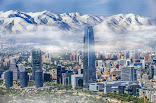WEEK 1: INTRODUCTION TO CHILE
The Andean mountain range runs the length of Chile and is home to many active volcanoes. The country has also experienced numerous powerful earthquakes, including the 2010 earthquake and tsunami that caused widespread damage and loss of life. Chile's location on the boundary of the Nazca and South American tectonic plates makes it particularly susceptible to seismic activity.
Chile's varied geography also includes an array of different climates and ecosystems. The Atacama Desert, for example, is one of the driest places on Earth, while the Patagonian ice fields are home to glaciers and ice caps. These contrasting environments have led to a diverse array of plants and animals, many of which are found nowhere else in the world.
 I chose to focus on Chile's geology because of the country's unique and extreme natural events. The combination of earthquakes, volcanoes, and tsunamis in one place makes Chile a fascinating case study of the forces that shape our planet. Additionally, the country's diverse geography and ecosystems offer a wealth of opportunities for scientific research and exploration.
I chose to focus on Chile's geology because of the country's unique and extreme natural events. The combination of earthquakes, volcanoes, and tsunamis in one place makes Chile a fascinating case study of the forces that shape our planet. Additionally, the country's diverse geography and ecosystems offer a wealth of opportunities for scientific research and exploration.
Hazards, disasters, and catastrophes are related but distinct concepts.
A hazard is any event or situation that has the potential to cause harm or damage to people, property, or the environment. Examples of hazards include earthquakes, hurricanes, and wildfires. Hazards can be natural or human-made, and they can be sudden or gradual.
A disaster is a significant disruption caused by a hazard that exceeds the ability of the affected community to cope with using its own resources. Disasters can be natural or man-made and can include events such as hurricanes, floods, and oil spills. They cause damage and loss of life and may require external assistance to respond to and recover from.
A catastrophe is a rare, large-scale event that causes massive damage and loss of life. It often results in widespread human suffering, economic disruption, and the need for long-term recovery. Examples of catastrophes include major earthquakes, volcanic eruptions, and nuclear accidents.
References:
https://en.wikipedia.org/wiki/Geology_of_Chile
https://www.britannica.com/place/Chile





Hi Rahil! I wanted to comment on Chile as my country, Peru, is just to the north and we share many of the same geographic conditions. Attached is the link for a short video on the tectonics and earthquakes of Peru and Chile that you might like:
ReplyDeletehttps://www.iris.edu/hq/inclass/animation/peruchile_subduction_zone_earthquakes__tectonics
Besides seismic activity both our countries share weather related events due to ENSO, or El Niño Southern Oscillation, which can cause dramatic shifts in weather patterns. I was also fascinated to read that there are over 1,800 volcanos on the border of Chile and Argentina. Below is a link to a chapter from a FEMA book on hazards in Chile you might find interesting.
https://view.officeapps.live.com/op/view.aspx?src=https%3A%2F%2Ftraining.fema.gov%2Fhiedu%2Fdownloads%2Fcompemmgmtbookproject%2Fcomparative%2520em%2520book%2520-%2520chapter%2520-%2520chili%27s%2520civil%2520defense%2520and%2520lack%2520of%2520mitigation.doc%23%3A~%3Atext%3DThe%2520earthquake%2520in%25201985%2520that%2CVolanoes.&wdOrigin=BROWSELINK